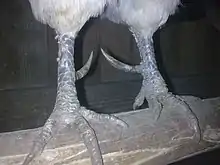sɛ̃³⁵
Pela
Pronunciation
- IPA(key): /sɛ̃³⁵/
Etymology 1
Borrowed from Jingpho Sam (“Tai, Shan”), from either a Tai language or Burmese သျှမ်း (hsyam:) ~ ရှမ်း (hram:). Compare Thai สยาม (sà-yǎam, “Siam”), Lhao Vo Sam” vo, Zaiwa Sam and Longchuan Achang sam³¹.
Derived terms
- sɛ̃³¹ va⁵⁵ (“Tai people”)
- sɛ̃³⁵ maŋ³¹ (“Thailand”)
- sɛ̃³⁵ pju⁵⁵ mju⁵⁵ (“Tai people”)
See also
- xɛ⁵⁵, xɛ⁵⁵ va⁵⁵ (“Han people”)
- ti³¹ va⁵⁵, ti³¹ ta³¹ (“Jinghpo people, Kachin people”)
- mjɛn³¹ (“Burmese people”)
Etymology 2

Only found in Maruic languages. Compare Lhao Vo sin꞉ do;, Zaiwa woq san, and Lashi khyid꞉ sain”.
Derived terms
- kʰji⁵⁵ sɛ̃³¹ (“spur (of a cock)”)
- ɣaʔ³¹ kʰji⁵⁵ sɛ̃³¹ (“spur (of a cock)”)
Etymology 3
From Proto-Sino-Tibetan *sjwar ~ g/b-sjwa-n/t (“flow; pour; scatter; spill; sow; broadcast”). STEDT compares the root to Burmese သွန် (swan, “to pour out, to shed”) and Old Chinese 散 (“to come loose, to scatter”), 灑 (“to sprinkle”), yet the medial /-w-/ in Burmese remains unexplained, while the Pela form (together with most other Burmish forms) reflects an earlier *-an rather than *-wan, making their correspondence with Burmese unlikely. Compare Lhao Vo sin”, Zaiwa san and Longchuan Achang san³¹.
Derived terms
- sɛ̃³⁵ xa³¹ (“to sow, to plant”)
See also
- pja̠⁵⁵ (“to spread, to broadcast”)
References
- Dai Qingxia, Jiang Ying, Kong Zhien, A Study of Pela Language (2007; Publishing House of Minority Nationalities, Beijing)
- Huang Bufan (editor), Xu Shouchun, Chen Jiaying, Wang Huiyin, A Tibeto-Burman Lexicon (1992; Central Minorities University, Beijing)
- Mangshi Jinghpo ethnicity Association of Development and Progress Studies(芒市景颇族发展进步研究学会)(ed.), Han-Zaiwa-Pela Dictionary (汉文载瓦文波拉语对译词典) (2018; Dehong Nationalities Publishing House, Mangshi)